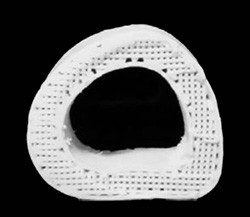By Ana Verayo, | September 29, 2016

Cross-section of a 3-D printed adult human femur.
In a new breakthrough, scientists have developed a new type of artificial bone using a 3D printer that can be custom fitted for implant surgery, inducing bone regeneration.
This new material, known as a "hyperelastic bone," appears and acts like a human bone inside the body. It can repair deformed bones including those shattered or broken by injury.
Like Us on Facebook
Researchers from the Northwestern University in Illinois tested a prototype of the bone in a monkey. The results show that the artificial bone merged to the monkey's skull and new blood vessels were being produced.
According to Adam Jakus from the Department of Materials Science and Engineering at Northwestern University, after a period of four weeks, the bone implant was fully integrated and vascularized with the monkey's original skull.
Scientists claim that this new material can be used in a variety of bone injuries, for the jaw, skull, and even the spine.
Currently, experts use a bone graft for patients, which can become painful and usually does not merge smoothly as the bone transplants do not heal well. Other bone grafting technology includes the use of brittle material and is at risk of rejection by the body.
The team hopes to test their 3D printed bone implants in humans within five years. This artificial bone implant is composed of materials like hydroxyapatite, which is the main mineral ingredient of natural bone.
According to Ramille Shah of Northwestern University, this 3D printed bone is mostly ceramic, but it possesses unique nano and micro structural properties making it highly elastic. After squeezing and deforming this material, it just bounced back to its original shape, Shah stated.
In the future, researchers hope to use these 3D printed artificial bones for custom made implants based on MRI and other scans since this new material can easily be cut and shaped into a more precise form.
This study has been published in the journal, Science Translational Medicine.
-
Use of Coronavirus Pandemic Drones Raises Privacy Concerns: Drones Spread Fear, Local Officials Say

-
Coronavirus Hampers The Delivery Of Lockheed Martin F-35 Stealth Fighters For 2020

-
Instagram Speeds Up Plans to Add Account Memorialization Feature Due to COVID-19 Deaths

-
NASA: Perseverance Plans to Bring 'Mars Rock' to Earth in 2031

-
600 Dead And 3,000 In The Hospital as Iranians Believed Drinking High-Concentrations of Alcohol Can Cure The Coronavirus

-
600 Dead And 3,000 In The Hospital as Iranians Believed Drinking High-Concentrations of Alcohol Can Cure The Coronavirus

-
COVID-19: Doctors, Nurses Use Virtual Reality to Learn New Skills in Treating Coronavirus Patients







